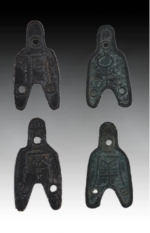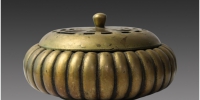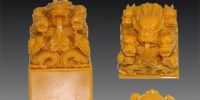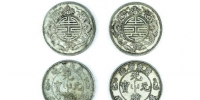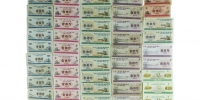2019迪拜春拍精品推荐:三孔布币(一组)
陕西嘉辉艺术品拍卖有限公司【藏.荐】栏 为藏品强大的传播效应向各位买家推荐经国家一级鉴定专家甄选的艺术珍品,为藏家牵线搭桥,让千百件艺术珍品价值被发掘与重视,在拍卖会上得以高价成交。
Shaanxi Jiahui Art Auction Co., Ltd. [Tibet. Recommendation] column recommends art treasures selected by national first-level appraisal experts to buyers for the powerful dissemination effect of the collection. It helps collectors to bridge the gap, so that thousands of art treasures can be excavated and valued, and can be sold at high prices in the auction.
【名称】 三孔布币
【规格】 20.6g/ 16.5g
【类别】 钱币
Three-hole cloth coin
[Specification] 20.6g/16.5g
[Category] Coins
布币,因形状似铲,又称铲布,从青铜农具镈演变而来,是中国战国时期流通于中原诸国的铲状铜币。铲状工具曾是民间交易的前言,故早泛起的铸币铸成铲状。初的布币,保留着其作为工具的容貌,留有装柄的的銎,原始而厚重,厥后逐渐减轻,变薄,变小,币身完全成为片状,便于铸造和携带。布币是中国古代钱币,因形状似铲,又称铲布。中国战国时期流通于中原诸国的铲状铜币。铲状工具曾是民间交易的前言,故早泛起的铸币铸成铲状。
三孔布币市场价值,三孔布是战国时期布币的一种,圆首圆肩圆足,因首部与两足均有一孔而得名。除三孔这一特点外,背文尚有“两”或“十二朱”以铢两为单元的计重,这在先秦布币中是的。有关三孔布的早记录来自清嘉庆二十四年(1819年),金石名家初尚龄所著的《吉金所见录》。以后历经百余年至今,三孔布已陆续发现差异地名30余种,种类虽多但每一品种均寥若晨星,不少为仅见孤品。“三孔布”堪称中国古泉第二泉,是“中国古泉五十名珍”中的第二珍。
本公司经过多年艺术品投资市场的锤炼和洗礼,受到众多收藏爱好者及业内人士的高度评价,自成立以来,努力促进中外文化交流与互动,获得多方文化机构与收藏爱好者一致好评,始终秉承一如既往的企业文化和经营准则,依托强大的买家群体和专业的专家团队,不断创新,不断开拓,不断优化与全球收藏家们的合作。
2019迪拜春拍精品推荐 :三孔布币(一组)
Cloth coins, also known as spade cloth, evolved from bronze farm tools, and were the spade-shaped copper coins circulating in the Central Plains during the Warring States Period. The shovel tool was the foreword of the folk trade, so the early coins were made into shovels. The original cloth coin retains its appearance as a tool, with a handle, primitive and thick, and then gradually reduces, thins and decreases. The body of the coin is completely flaky, easy to cast and carry. Cloth coin is an ancient Chinese coin. It is also called shovel cloth because of its shape. The spade-shaped copper coins circulated in the Central Plains during the Warring States Period of China. The shovel tool was the foreword of the folk trade, so the early coins were made into shovels.
The market value of the three-hole cloth coin is one of the cloth coins in the Warring States Period. The round head and round shoulder are round and full-footed. It is named for having a hole in the head and both feet. In addition to the characteristics of three holes, the back text still has "two" or "twelve Zhu" weighed in two baht units, which is true in the pre-Qin cloth coins. The early record of Sankongbu comes from the book "Jijin Zhilu" written by Chu Shangling, a famous epigrapher in Jiaqing in the Qing Dynasty in 1819. Over the past hundred years, more than 30 species of geographical names have been discovered in three holes. Although there are many species, each species is rare. "Sankongbu" can be called the second spring of ancient springs in China, and it is the second treasure of the "fifty treasures of ancient springs in China".
After years of refinement and baptism in the art investment market, the company has been highly appraised by many collectors and professionals. Since its establishment, it has striven to promote cultural exchanges and interaction between China and foreign countries, won unanimous praise from various cultural institutions and collectors, and has always adhered to the same corporate culture and business principles. Relying on a strong buyer group and professional expert team, we are constantly innovating, exploring and optimizing our cooperation with collectors around the world.
